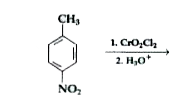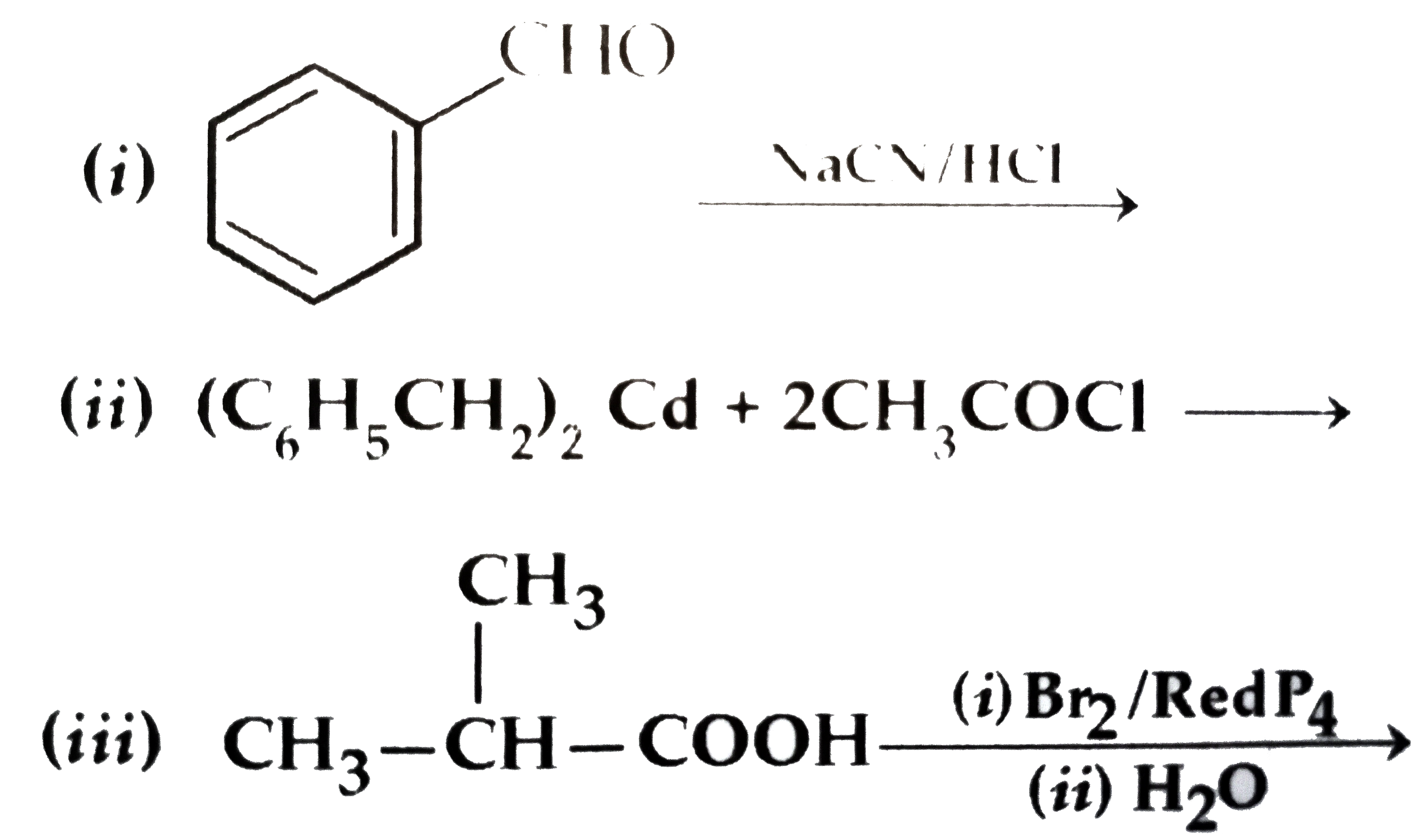Identify A in the following reactions : (C6H5CH2)2Cd+2CH3COCl→A
To identify compound A in the reaction (C6H5CH2)2Cd+2CH3COCl, we will follow these steps:
Step 1: Identify the reactants
The reactants are:
- Di-phenyl cadmium, represented as (C6H5CH2)2Cd
- Acetyl chloride, represented as CH3COCl
Step 2: Understand the reaction
In this reaction, di-phenyl cadmium reacts with two moles of acetyl chloride. Di-phenyl cadmium is a reagent that can react with acid chlorides to form ketones.
Step 3: Analyze the reaction mechanism
1. The cadmium atom in di-phenyl cadmium has a +2 oxidation state and is bonded to two benzyl groups (C6H5CH2).
2. Each acetyl chloride molecule will react with the cadmium, leading to the displacement of the chlorine atom.
3. The reaction will result in the formation of a new carbon-carbon bond between the acetyl group and the benzyl group.
Step 4: Write the products
The reaction can be summarized as follows:
- Each CH3COCl reacts with (C6H5CH2), resulting in the formation of a ketone.
- The byproduct of the reaction is cadmium chloride, CdCl2.
The main product formed will be:
- CH3COCH2C6H5 (which is phenylacetone).
Step 5: Finalize the product
Since there are two moles of acetyl chloride reacting with di-phenyl cadmium, the final product A can be represented as:
- 2CH3COCH2C6H5
Thus, the compound A is:
- A = 2 CH_3COCH_2C_6H_5 (or simply phenylacetone).
Summary
The final answer for compound A is:
- A = 2 CH_3COCH_2C_6H_5
---
The reactants are:
- Di-phenyl cadmium, represented as (C6H5CH2)2Cd
- Acetyl chloride, represented as CH3COCl
In this reaction, di-phenyl cadmium reacts with two moles of acetyl chloride. Di-phenyl cadmium is a reagent that can react with acid chlorides to form ketones.
1. The cadmium atom in di-phenyl cadmium has a +2 oxidation state and is bonded to two benzyl groups (C6H5CH2).
2. Each acetyl chloride molecule will react with the cadmium, leading to the displacement of the chlorine atom.
3. The reaction will result in the formation of a new carbon-carbon bond between the acetyl group and the benzyl group.
The reaction can be summarized as follows:
- Each CH3COCl reacts with (C6H5CH2), resulting in the formation of a ketone.
- The byproduct of the reaction is cadmium chloride, CdCl2.
- CH3COCH2C6H5 (which is phenylacetone).
Since there are two moles of acetyl chloride reacting with di-phenyl cadmium, the final product A can be represented as:
- 2CH3COCH2C6H5
- A = 2 CH_3COCH_2C_6H_5 (or simply phenylacetone).
The final answer for compound A is:
- A = 2 CH_3COCH_2C_6H_5
Topper's Solved these Questions
- PRACTICE PAPER 3Book:CBSE COMPLEMENTARY MATERIALChapter:PRACTICE PAPER 3Exercise:Very Short Answer Type Questions
Explore 32 Videos
- PRACTICE PAPER 1Book:CBSE COMPLEMENTARY MATERIALChapter:PRACTICE PAPER 1Exercise:Questions
Explore 82 Videos
- PRACTICE PAPER 4Book:CBSE COMPLEMENTARY MATERIALChapter:PRACTICE PAPER 4Exercise:SECTION : C
Explore 39 Videos
Similar Questions
Knowledge Check
In the following reaction C2H6C(CH3)(C6H5)Br
AC6H5CH3BC6H5CH2CH2C6H5CC6H5CH2OCH2C6H5DC6H5CH2OHThe main product of the following reaction is C6H5CH2CH(OH)CH(CH3)2conc.H2SO4−−−−−−−→?
A B
B C
C D
D
The main product of the following reaction is , C6H5CH2CH(OH)CH(CH3)2conc.H2SO4−−−−−−−→
A B
B C
C D
D
Write the structures of products of the following reactions :
(i)
(ii) (C6H5CH2)2Cd+2CH3COCl→
(iii) H3C−C≡C−HHg2+,H2SO4−−−−−−−−→

View SolutionComplete the following reaction equations :
(i) C6H5N2Cl+CH3COCl→
(ii) C2H5NH2+C6SO2Cl→
(iii) C2H5NH2+HNO2→
View SolutionName the reagent used in the following reactions:
C6H6−CH2−CH3?−−→C6H5−COO−K+
View SolutionWrite the structures of the major products in the following reactions :
(i)CH3CH=C(CH3)2+HBr→(ii)C6H5ONa+C2H5Cl→
View SolutionIdentify A and B in the following reaction sequence .
CH3−C∣CH3H−CH=CH2+HBr→(A)C2H5O−−−−−−−−→C2H5OH(B)
View Solution
